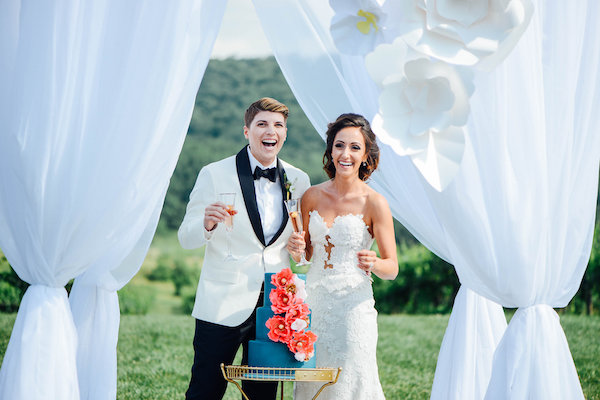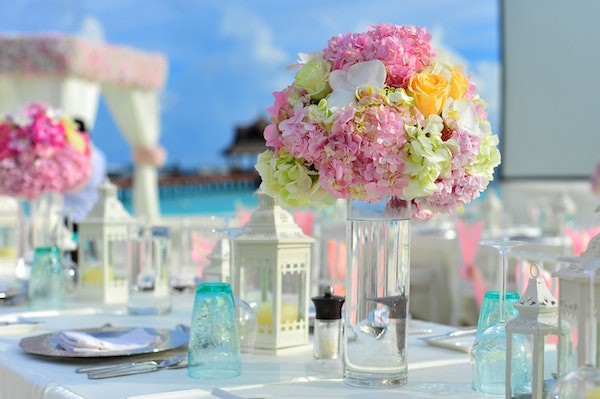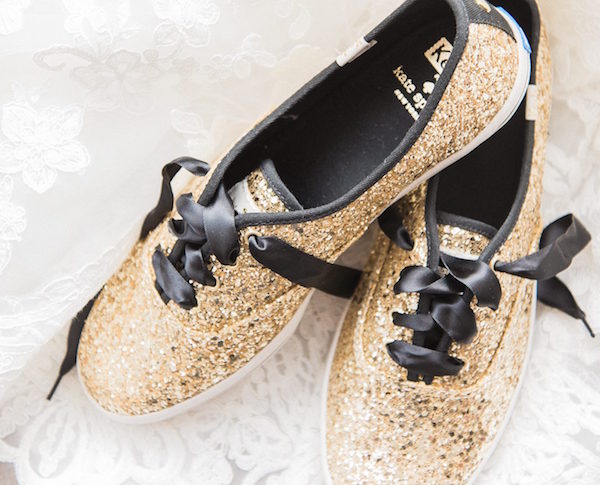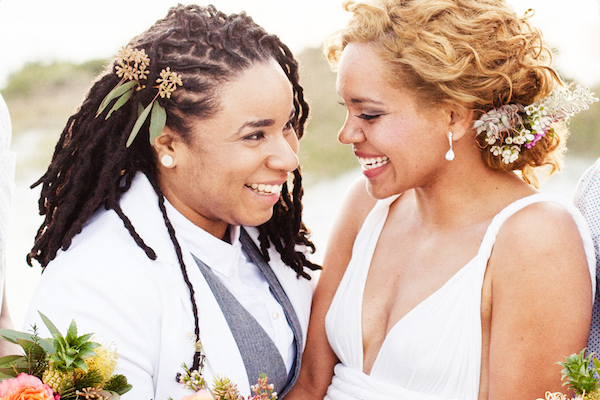6 Tips on Navigating Wedding Traditions When Planning an LGBTQ Wedding
The wedding industry leads us to believe that planning a wedding and getting married is just a series of Instagrammable moments and pretty, happy people. While for many couples, a beautiful wedding or marriage ceremony is the best way to begin the rest of their lives together, the truth of the matter is that weddings are hard work and full of logistics, pressure, and emotions.
For LGBTQ couples, there can be even more stress in dealing with the overly heteronormative nature of “traditional” weddings. Most couples have to deal with families and friends who aren’t experienced LGBTQ wedding–goers, which can lead to awkward questions regarding the traditional wedding experience and how the couple’s wedding day will play out.
Unlike heterosexual couples, LGBTQ couples aren’t steeped in centuries of wedding traditions—and that’s a great thing! As a wedding planner, I’ve seen all kinds of trends come and go, but with marriage equality now the norm, weddings have become more personalized than ever for couples of all genders and orientations.
This advice is here to help you navigate your wedding planning process and give you permission to create the special day you truly want. It’s time to forget your not-so-straight path to your wedding day!
1. Labels
As an LGBTQ person, you’ve likely had to “label” yourself many times and explain what that label means to you. Your wedding will likely require you to do the same, but don’t let anyone put you in a box you don’t want to be in.
The words “bride,” “wife,” and “Mrs.” might not feel like a good fit for you, even if you identify as a woman—and that’s okay. Alternatives to “bride” include “groom,” “bridegroom,” or even “broom” or “gride.” You can be a partner or a spouse instead of a wife, and you can choose “Ms.” or the gender-neutral title “Mx.” You can also emphasize your names instead of labels throughout your ceremony and reception.
No matter your preference, ask guests and vendors to refer to you in the ways you’d like to be referred to.

2. Budget & Expenses
In the past, there was an expectation that the bride’s family paid for the wedding reception and the groom’s family paid for the rehearsal dinner. That structure doesn’t necessarily work for LGBTQ couples, and today, most couples cover wedding expenses themselves or receive contributions from various family members.
The best way to handle your budget is to have anyone who wants to contribute to your wedding make their contribution directly to you (via check or Venmo, for example) so you and your partner can use the funds where you want or need.
Other options include splitting the cost 50-50 between each partner’s family or splitting it three ways between the wedding couple and each family. Discuss the details with your families beforehand so you can make sure everyone is comfortable with the situation.
3. Vendors
One of the most important factors in how your wedding will unfold will be your wedding vendors, including your wedding planner, venue, caterer, photographer, and videographer. Your vendors’ understanding of the complexities of designing a wedding that’s meaningful to you can make or break your planning experience and wedding day.
Unfortunately, despite the legalization of same-sex marriage, many LGBTQ couples planning weddings feel like they have to “come out” over and over again when finding vendors. They experience contracts made out to the “bride” and “groom” and assumptions that there’s a masculine man marrying a wedding-crazed woman.
You can get a feel for a vendors’ experience with working with LGBTQ couples before you contact them. Pay attention to the language and imagery used on vendors’ websites and social media. Is a vendor’s website geared just toward a bride? When you see images on Facebook and Instagram, do you see couples that look like you? (If you don’t necessarily see yourself, do you see a range of couples in regards to sexual orientation, race, and even religion?) Do contact forms and contracts use gendered, heteronormative language?
An equality-minded wedding planner can help direct you to like-minded wedding vendors, even if you don’t want to hire a full-service wedding planner.
And remember—a good vendor will ask you questions about the look and feel you want for your wedding day instead of telling you how your wedding should be done.

4. The Wedding Party
Marriage equality has made mixed-gender wedding parties more common for LGBTQ and heterosexual couples alike. Are you a woman with a male best friend? It’s totally acceptable for him to stand next to you at the altar.
When it comes to wedding party attire, gone are the days of matchy-matchy. Mixing colors and textures looks gorgeous in your photos and your friends and family will be happier wearing something they are comfortable in. Giving your wedding party guidance is always a good idea, but allowing for each person to choose the specific design of their attire, for example, is a great way to have a happy wedding party.
Also, don’t feel the need to have a wedding party at all. Most states only require one witness (and some, like Washington, D.C., don’t even require that) so legally, it’s not a requirement. If you have a large group of friends and want them all there with you, then have them all. Or perhaps just having one attendant feels right to you.
5. Attire
Too many LGBTQ couples getting married are asked, “Who’s wearing the dress and who’s wearing the suit?” The most important thing to consider when choosing your wedding attire is what will make you feel like the best version of yourself, not what other people might expect or want you to wear.
Determining how formal you want your wedding attire to be is a good approach to figuring out what you’ll be most comfortable wearing. Perhaps you’d rather wear a colorful cocktail dress instead of a white gown or a suit vest instead of a full blazer.
Keep in mind that an outfit change is an option too. For example, a gown might feel like the right choice for your ceremony, but slacks and a blouse or a jumpsuit might feel more comfortable for dancing the night away at your reception.

6. The Ceremony
The marriage ceremony itself can be one of the most difficult parts of a wedding for LGBTQ couples. It’s the part of the day most deeply rooted in heteronormativity, so figuring out logistics can feel tricky or icky. Many LGBTQ individuals must also navigate emotions stemming from not having the support of family or their religions or cultural backgrounds.
Wedding ceremonies have traditionally followed this basic structure:
- Processional
- Opening remarks/officiant’s address to the couple
- Declaration of intent
- Exchange of vows
- Exchange of rings
- Pronouncement of the marriage
- Kiss
- Recessional
Some ceremonies also include readings, music, or unity rituals.
When it comes to the processional, decide if one or each of you wants to be “given away,” i.e. walk down the aisle with your parent(s) or another significant person. If you don’t want to be “given away,” consider entering and walking down the aisle together or one after the other. If you can’t decide who wants to walk first, consider a floor plan with two aisles and walk in at the same time. (A rowdy game of rock, paper, scissors can also help determine this decision!)
Don’t be afraid to write your own ceremony and vows. There are amazing resources online to guide you in this process, and your wedding planner and officiant can also assist you. Writing your own ceremony allows you to include or exclude traditional structures, rituals, and language.


